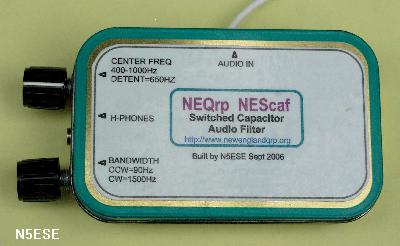New England QRP NESCAF Kit
Switched Capacitor Audio Filter

(click on any picture to see larger version)

QRP kit builders and homebrewers are always looking for cheap and effective means to make their simple kits perform like their more expensive commercial counterparts. It's a real joy to build a simple regen, direct conversion, or superhet receiver and hear it pull those weak signals out of the ether. There's nothing like the feeling of having built an operable piece of radio gear. After some time playing with it, however, one frequently uncovers the compromises that go into designing a simple, cheap circuit. One of the most frequent complaints is poor selectivity, which translates operationally to difficulty in discriminating among several signals which can be heard in the output. The good news about this is that the human brain implements one of the best audio signal processors in the universe. Of course, it has to train itself, and not everyone has the patience for that. Also, a certain amount of fatique comes with using the brain as the primary filter.
Along comes the New England QRP Club, which now offers an inexpensive, but state-of-the-art Switched-Capacitor Audio Filter kit, called the NESCAF. Priced at under $30, the kit includes all this:
(click on any picture to see larger version)The NESCAF uses a MF10 chip to implement a 4th-Order Butterworth Bandpass audio filter. Using the Butterworth topology results in a smooth filter action with little or no ringing, but compromises on the skirt selectivity somewhat. Even so, the filter can provide dramatic results. The switched-capacitor circuitry requires a digital clock at 100 times the center frequency, but it does not require digital control. The circuit uses a timer (LM555/NE555) oscillator to provide a tunable clock, whereby the center (peak) frequency can be controlled by the user, via a front panel potentiometer. An additional front panel pot allows the user to vary the bandwidth. Using these controls, the center frequency can be tuned from about 400-1000 Hz, with an adjustable bandwidth of 90-1500 Hz (suitable for CW applications). Not a bad set of features (and for a mere pittance).
One of the shortcomings of many filter implementations is output power. Such is not the case here. An LM386 amplifier chip is provided, with enough output power to easily drive a pair of headphones or an efficient speaker. This circuit is designed to input audio from a standard headphone jack, and output it in like manner. With plenty of reserve audio gain and output power, the filter can serve to augment a simple receiver with otherwise weak audio. And that's a nifty little "plus".
Construction
Board Assembly is straightforward for anyone who has built kits before. Instructions (available in a PDF file on the NEQRP site) are very clear, checklist-style. All assembly is "through-hole" (not surface mount):
I do wish kit designers would consider putting all I/O compoents (pots, power connectors, output connectors) on-board, because the bulk of the assembly effort (and time spent, and burned fingers, and wiring errors) come from mounting the controls and wiring them up. Rarely is material cost saved by using panel-mounted controls, but it does take a little extra diligence and forethought during the printed circuit layout stage. Believe me, you'll garner nothing but praise for making the effort.
OK -- Big Surprise -- my immediate goal was to package this in an Altoids tin, completely self-contained, including 9-Volt battery. I wanted to be able to stuff it in my field kit for portable ops, and an Altoids tin is perfectly sized and very rugged in that application. The pc board is about 2 x 2 inches, and will fill nicely in the tin. Given the two pots provided, it's a very tight fit, but as you can see, it can be done.
(click on any picture to see larger version)Finally, to clean up the look somewhat, we printed labels for the top and inside cover. Besides making it look a tad less rustic, it serves to remind us months from now what the function of each control or I/O connector is. This can be important for a piece of hardware that gets stored away in a field kit for who-knows-how-long.
(click on any picture to see larger version)Performance
We were very pleased with how this kit performs. I've tried it on some of my "wideband" receivers, and it easily served to reduce annoying hiss, eliminate nearby signals, and boost the audio somewhat. The sound is surprisingly crisp and clean, much more so than many op-amp filters I've built. Weak signals were easily discerned. And I could hear no digital artifacts (from the clock circuit). There is (as was expected) some minor ringing when centered on a strong CW signal or when inundated with hash noise. This can generally be alleviated by backing off on the bandwidth slightly. [Besides, who needs a filter on a strong CW signal?] It won't compete with a DSP, but it won't cost $200 either ;-)
However you package it, or however you decide to use it, I highly recommend the NESCAF as a useful accessory for home station or portable use.
73,
Monty N5ESE
dit dididit dit
Return to N5ESE home page
Overseer: Monty Northrup ...... leave e-mail ...